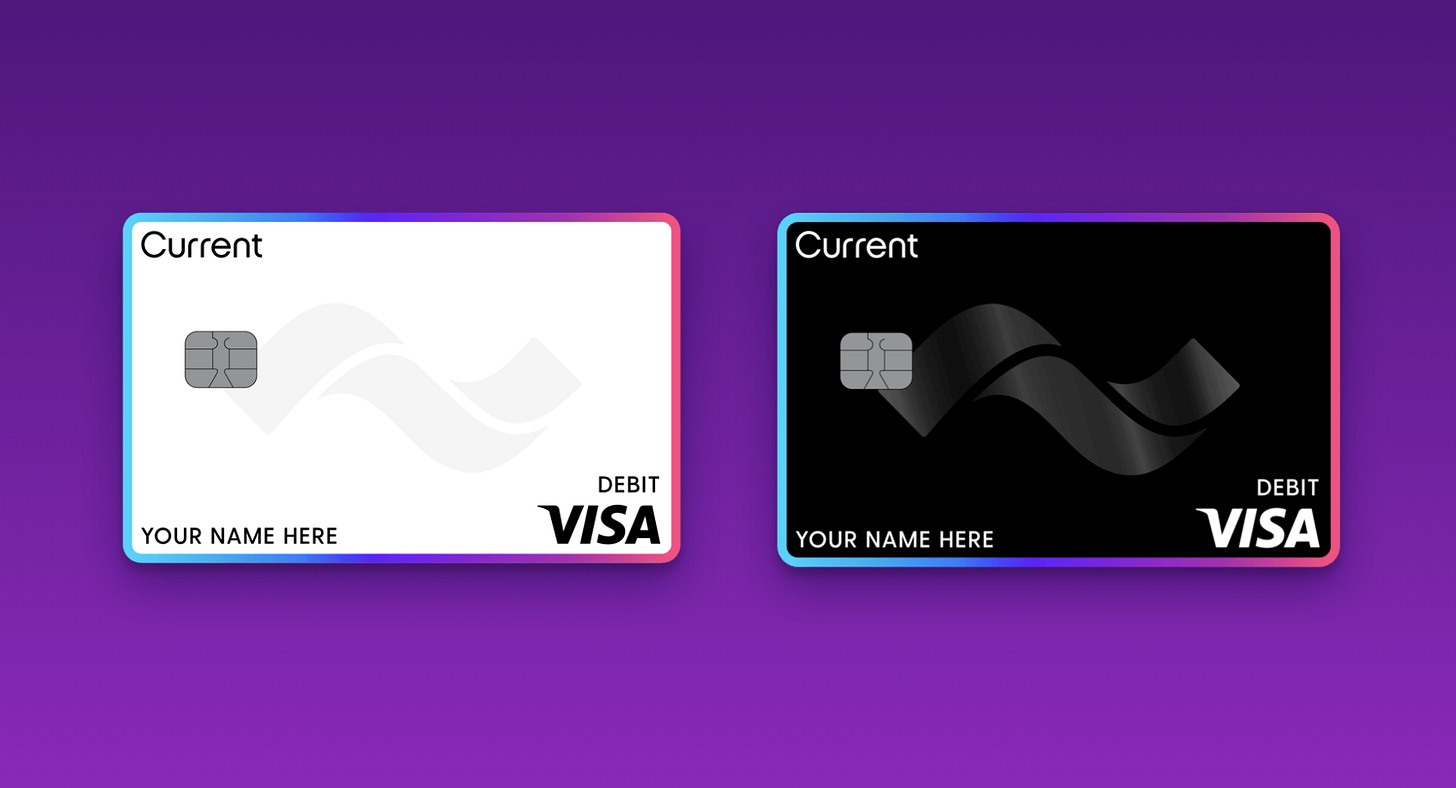

Discover more from Fintech Radar
Current: Doing It Differently
For this special issue of FR, I interview Stuart Sopp, CEO and Founder of US challenger bank Current.

Current is an interesting case study in the world of challenger banking.
In a market that is obsessed with banking H.E.N.R.Y millennials, Current has instead focused on banking those who have been left behind by incumbent banks. Yes, they do have a shiny debit card that is reminiscent of many others out there, but their core value proposition and the market they’re going after is vastly different to the other glistening debit cards out in the market.
The mass affluent (and soon to be affluent) market has been flooded with challenger bank propositions offering massive cash backs and points on purchases, the ability to buy crypto and trade stocks. These might work well in SF and NYC, but in a country where there are ~70-80m households living paycheck-to-paycheck, these features don’t hit the same everywhere.
Current’s core customers have very different needs and thus require a product that is focused on a different set of ‘jobs to be done’. The ability to pay their bills on time to avoid punishing late fees, not having to worry about account fees on low balances and moving money quickly are features that matter much more to them than being able to buy ETH. Current is focused on addressing this growing market of customers, and it appears that their value proposition is resonating.
Current has over 1.5m accounts and like many neobank in the US has been growing rapidly during COVID-19. At a recent Credit Suisse event, they noted that they’d seen some serious growth during the last few months, reaching a ~1,300% annualised customer growth this year - which has since settled at a still impressive ~800% growth rate. Not too shabby at all.
However, beyond their focus on those who’ve traditionally been underserved by incumbent banks, what makes Current interesting is that they’ve gone against the grain in other areas of their business. For example, they started life as a teen-focused banking proposition (and have since graduated to banking for all), they built their own core banking platform and have recently decided to offer their customers the ability deposit money at physical locations like 7-eleven - which if you ask many in fintech, are all things that they’d advise you against doing.
Whenever I see a startup making a sharp left-hand turn when others are going right, my ears prick up. Current has been on my list of neobanks to write about for quite some time. So when I had the chance to ask Stuart Sopp, their CEO and founder, about moving beyond teen banking, what his advice would be to founders thinking about building their own core banking platform, going global and being a bank, I jumped at the opportunity.

Image: Stuart Sopp, CEO and Founder at Current
Teen-focused Banking As A Wedge
Current started life back in 2017 as a teen-focused banking proposition. The use case was simple; it was a product aimed at helping kids spend, save and give (check out this piece in Techcrunch when they initially launched).
Much like Greenlight and GoHenry currently serving the teen market, they allowed parents to set chores and track their child’s spending patterns and encourage saving. The product is still available, but in many ways, Current seems to have moved on from this product being the core of their offering.
Most challenger banks serving teens harbour aspirations to move into a broader market, but no one aside from Current has done it successfully. Here’s what Stuart had to say about how they thought about servicing an older demographic.
Alan: I think Current is a great case study in how a challenger bank proposition can use an initial wedge (in your case, teen banking) as a testing bed for the core technology and product, then use those learning to move into a broader (and more profitable) market. Why did you choose teen banking as the initial market wedge, and how did you know it was time to move to a broader market segment?
Stuart: Our strategy was to build a banking infrastructure from scratch and that necessitated less features as we started because we saw there was an advantage in getting to market quickly and teens needed fewer features but still needed faster, more convenient money and good financial tools. As we have built out our proprietary technology and feature set, we’ve been able to service an even larger and older demographic with our personal checking accounts for adults, which we launched in 2019. We are a multi-product fintech and we’ve seen the value of the teen product grow over time. We’ll be looking at offering other family products in 2021, including joint accounts.
What? Building Core Banking Infrastructure?
Few neobanks have gone down the path of building their own core banking platform, and this is exceedingly rare if you’re relying on an issuing bank partnership (Current’s issuing banks are Choice Financial and Metropolitan Commercial Bank). In fact, you can count on one hand the other challenger banks who have decided to take this task on themselves. To be honest, it’s a crazy idea.
The cost, time and complexity associated with building a core banking platform are all reasons why most neobanks outsource this job to the likes of Mamba, Temenos or ThoughtMachine (or maybe if SAP if you’re ex-banker).
However, if you can actually pull off building out your own platform, it can be a substantial competitive advantage. So I decided to ask Stuart, how he’d advise startup on the choice to build core technology inhouse.
Alan: In the world of challenger banking, not many have elected to build their own core banking system. Current is one of the few that have made that investment with Current Core. There are many advantages to bringing this part of the tech stack in-house. For example, I know you've noted previously that this brings the cost of opening a bank account down to a staggeringly low $0.15 per account. I also imagine this allows you to move quickly in your product development cycles. However, this approach probably isn't the one every challenger bank should take. How would you advise a startup thinking about following your footsteps and building mission-critical financial infrastructure in-house?
Stuart: My advice would be that it is a long and arduous road, which only reaps rewards several years into the business. You have to balance the critical financial infrastructure innovation along with growth and product development at same time, which is very hard. Anyone would have to think carefully if they can build a company on infrastructure alone vs. utilizing a third party and going after growth and continuing to build out the infrastructure at the same time.
Being A “Bank”
The debate around choosing to be a chartered banked vs riding on an issuing bank’s licence always elicits strong views. It’s the equivalent of asking a child of the 80s which is better, East Coast or West Coast rap. You get the point.
To date, Current has worked with Choice Financial and Metropolitan Commercial Bank as their issuing banks and has publicly said that it’s ‘deposit agnostic’. However, we’ve recently seen the likes of Varo and Square obtain their own banking charters, which begs the question of whether others, like Current, will follow suit.
A shift from ‘renter’ to ‘owner’, for most challenger banks is a massive shift in their business model. In this regard, I was curious how Stuart thought about this challenge from Current’s perspective.
Alan: One of the things you've noted in previous interviews is that Current is 'deposit agnostic' - meaning building a big deposit base isn't a core focus of the business. In turn, this has meant that to date, you've worked with an issuing bank to provide settlement for Current. This approach obviously has advantages and disadvantages. What would need to change for you to seek a banking charter in the US?
Stuart: We wouldn’t have to change all that much other than specifically needing to have a lot in capital reserves to service the charter. Economically though, there are such great deals with partner banks now, the costs are significantly less than going after your own banking license. If you’re not trying to get into lending to more affluent people, it doesn't make a lot of sense to pursue a charter. If we wanted a bank license it means we’d have to target more affluent people and have a change in our business model and then we’d be directly competing against traditional banks where I don't see a particularly big problem to solve at the moment.
Going Global?
In the last year, we’ve seen the European challenger banks plot their entry into the US. Monzo, Revolut and N26 have all established a presence across the Pond and are trying to build momentum in a market that is vastly different to that of the UK (where they’ve all cut their teeth).
However, to date, their growth has been lacklustre at best. There are many challenges when launching in another country. Everything from localisation, business model adjustments, value proposition changes and the list goes on. Having said this, the opportunity to grow internationally is something many challenger banks are finding hard to resist. I thought I’d ask Stuart how he thought about international expansion.
Alan: In the US, roughly 80m households live paycheck to paycheck with an average annual income of less than $75,000 per annum, which means there are still many customers that Current hasn't yet reached. Having said this, there are many other markets where Current's offering could also be compelling. In this regard, how do you think about international expansion?
Stuart: I think international expansion for our business model isn’t warranted at this stage. Wealth inequality is a very large problem still here in America and both the financial needs in other countries and their business models are all very different and specific with varying requirements for everything from legal, regulatory and compliance. It is a business that is very hard to scale internationally due to the unique nature of each country. There are very few global banks in the incumbent industry and they’ve all grown through acquisition for that reason. International expansion is a mirage for infant fintech.
Contrarian Takes
Lastly, I thought I’d ask Stuart about whether he has any contrarian takes on what’s going on in the challenger banking space.
Alan: Lastly, what do you believe to be true about the challenger banking space in the US that few agree with you on?
Stuart: I think that disruption in finance and banking has just begun and not just ended. It’s taken many years to get to this point of scale for many of us and it is not a winner-takes-all market. We’re still in the first few innings of this game, not the bottom of the ninth.
Corrections: Current now has 1.5m customers (originally stated as 1.4m) and is also banked by Choice Financial (originally stated as being just MCB).
🙏 Thanks to Stuart and Erin out at Current for finding time to answer my questions. Much appreciated.
Ps. If you like what I'm doing with FR, please feel free to share it on your social disinformation network of choice. Also, I'd appreciate it if you forwarded this newsletter to a friend you think might enjoy it.




